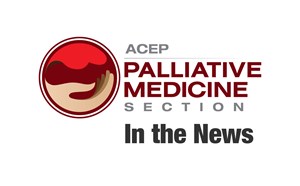
News and Notes
Section Achievements for 2015-16
2015-16 was a busy and productive year for the section.
- The section produced two newsletters.
- Eric Shaban, MD was our educational presenter at the section meeting in Las Vegas and spoke on “How is MACRA and MIPS going to Impact Your Practice?”.
- The section hosted a POLST information table at ACEP16 as the outcome of a Co-sponsored council resolution, Physician Orders for Life-Sustaining Treatment.
- The Curriculum Subcommittee completed the milestones and decided to condense their work into a 2-page brief, summary and highlights document to share with other organizations.
- A section grant application was submitted for: Palliative Care Curriculum Committee Work Product: Creating Common Core Palliative Care Education for Emergency Medicine.
- The Palliative Medicine Section Facebook page gained 100 followers and continues to grow.
- The section continued its participation in EM Forum at AAHPM.
- Section members presented five courses at ACEP16 on palliative medicine and end-of-life care (EOL).
- The section received a 2016 Service to College Award for contributions to the ACEP Ethics Committee information paper on palliative and EOL in the ED, palliative care guidelines in EM and for leadership strengthening relationships with other EM organizations.
- Several abstracts were presented at Research Forum on new category of palliative medicine and end of life care.
- The ACEP Simple Palliative Toolkit was added to the section microsite.
- A commitment statement was submitted to the IOM and the Chair was invited to represent ACEP at National Academy of Medicine meeting on EOL care.
- The Chair also participated in MOC subcommittee working on Part IV as content expert.
- The section contributed to an information paper developed by the ACEP Ethics Committee to fulfill 2015-2016 ACEP Ethics Committee Objective #6 - Develop an information paper on the ethics of palliative and end of life care in the ED. Work with the Emergency Medicine Practice Committee, Medical-Legal Committee, and the Palliative Medicine Section, as needed.
- The Chair submitted an article on POLST for ACEP Now and to include in Chapter Newsletter.
New Officers
Sangeeta Lamba, MD, FACEP
Chair and Councilor
Eric Isaacs, MD, FACEP
Chair-Elect
Anthony Loffredo, MD
Secretary/Newsletter Editor
Rachel Pearl, MD
Secretary/Newsletter Editor
David Wang, MD
Secretary/Newsletter/Microsite Editor
Kate Aberger, MD, FACEP
Immediate Past Chair
Rebecca Goett, MD
Alternate Councilor
Marny Fentzer, MD
Past Secretary/Newsletter editor
Mark Rosenberg, DO, MBA, FACEP
Board Liaison
Loren Rives, MNA
Staff Liaison
New website, new ideas
Asked to give a talk on symptom management of integrating palliative care into your ED? Want to connect with other EM thought leaders on a specific topic within palliative care? Curious if any new landmark research is moving the field forward? The revamped ACEP Palliative Section website can be useful to you! Please contribute material and join the movement!
Emergency physician Tammie Quest to lead AAHPM in coming years
Congratulations to Tammie Quest, a pioneer of palliative care in emergency medicine, on her appointment as President-Elect of AAHPM! We are excited for Tammie to continue building relationships between our organizations. Tammie will advance the emergency department's role in palliative medicine's continuum of care.
Pro-Tip for Your Next Shift: Opioid drips are too slow for effect in the ED
Picture this: You've just wrapped up a goals conversation for an elderly patient with pneumonia and are transitioning to comfort care. The admitting team asks you to start a morphine drip while he boards in the ED. One hour later, the nurse reports the patient still has a respiratory rate of 32 and asks how much to should go up on the drip. Thoughts?
Opioid infusions obey the pharmacokinetics of all infused medications. They require 4-5 half-lives to reach steady plasma concentration. Morphine and hydromorphone, two opioids frequently used in infusions to relieve pain and dyspnea at the end of life, both carry half-lives of approximately 2 hours. Thus, their infusions require 8-10 hours before the patient experiences that effective "hourly dose." In the interim, without bolus dosing, the patient's symptoms are likely not being adequately addressed. When ordering opioid infusions, it is mandatory to also order opioid boluses to carry them through that first 8-hour period.
Bottom line: It helps your inpatient colleagues to start an opioid infusion in the ED; it helps your patient to order opioid boluses.
David H. Wang, MD
Palliative Medicine, University of California San Francisco
Emergency Medicine, Kaiser Permanente San Francisco


